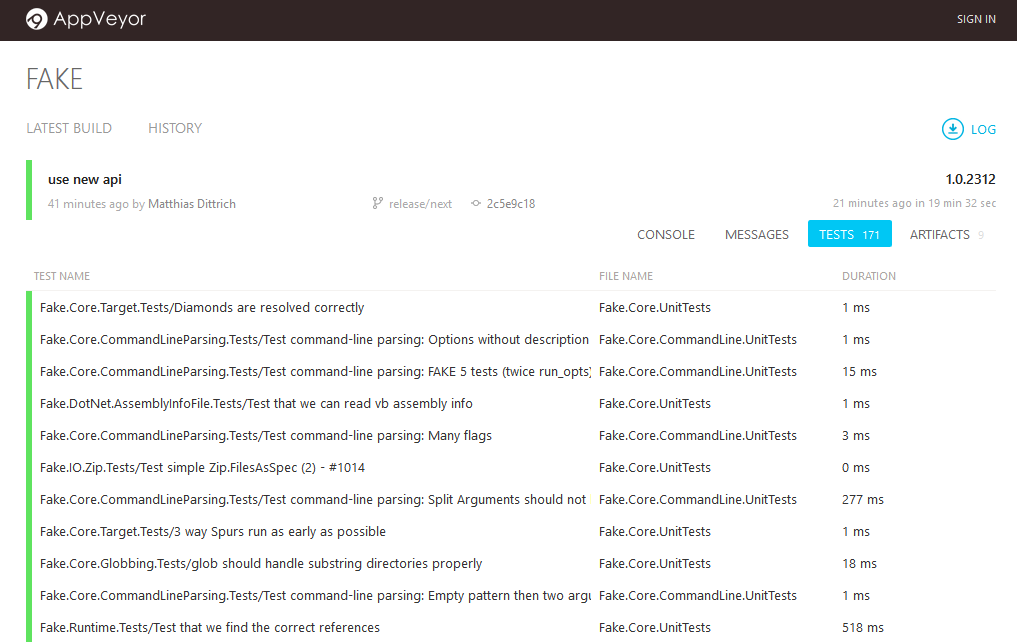Build Servers in FAKE
The Fake.Core.BuildServer namespace bundles support for various Build-Servers.
Supported Build-Servers (Note: Not supported doesn't mean that it won't work, but colors and deep integration might be missing):
Fake.BuildServer.AppVeyorFake.BuildServer.TravisFake.BuildServer.TeamCityFake.BuildServer.TeamFoundation
General API usage
Generally there is no need to write a script with a particular build server in mind. The usual integration works by pulling
the Fake module and calling BuildServer.Install [ Server.Installer ].
By using the Fake.Core.Trace-Api Fake will use all available build-server features and provide the best integration into
the platform. If you feel like we missed some feature on your CI/CD-server please let us know and open an issue.
Or consider sending a pull request.
Example:
#r "paket:
nuget Fake.BuildServer.TeamCity
nuget Fake.BuildServer.TeamFoundation
nuget Fake.Core.Target //"
open System.IO
open Fake.Core
open Fake.BuildServer
BuildServer.install [
TeamCity.Installer
TeamFoundation.Installer
]
// If you additionally want output in the console, even on the build-server (otherwise remove this line).
CoreTracing.ensureConsoleListener ()
Target.create "Test" (fun _ ->
File.WriteAllText("myfile.txt", "some content")
// traceTag can be used to open scopes/blocks. They will be shown in the build-server visualization if supported.
( use testsuite = Trace.traceTag (KnownTags.TestSuite "some-testsuite") "Starting unit test"
( use _ = Trace.traceTag (KnownTags.Test "some-test") "Starting unit test 1"
// Scope of the test
Trace.testOutput "some-test" "standard output" "standard error")
( use _ = Trace.traceTag (KnownTags.Test "some-test2") "Starting unit test 2"
// Scope of test2
Trace.testOutput "some-test2" "standard output" "standard error"))
// Uploads an artifact no matter the build-server
Trace.publish ImportData.BuildArtifact "myfile.txt"
// Uploads test results no matter the build-server
// Note: There might be limitations on some system with some imports.
// Please help by testing, submitting issues and pull requests.
Trace.publish (ImportData.Nunit NunitDataVersion.Nunit) "Fake_Core_CommandLine_UnitTests.TestResults.xml"
Trace.setBuildNumber "my-build-number"
Trace.traceImportant "tries to write in yellow"
Trace.trace "tries to write in green"
Trace.log "tries to write in white (normal color)"
)
Implementing support for a build-server
Please look at the existing implementations. Please contribute new implementations to the repository. Some changes like adding
new cases to the TraceListener module are not considered breaking changes. Using these types (using match on these types
to be exact) outside the fake repository is not considered good practice.
Example FAKE repository
Fake itself uses GitHubActions support for importing and displaying test results:
// import test result
Trace.publish (ImportData.Nunit NunitDataVersion.Nunit) "Fake_Core_CommandLine_UnitTests.TestResults.xml"
// upload artifacts
Trace.publish ImportData.BuildArtifact ("release/dotnetcore/fake-dotnetcore-win-x64.zip")
Also, prior to currently setup of FAKE which uses GitHub actions. The previous setup used VSTS (Azure DevOps) and AppVeyor. Look at this CI-build for an example on how it looks in VSTS, and the following image shows how it looks like in AppVeyor:
